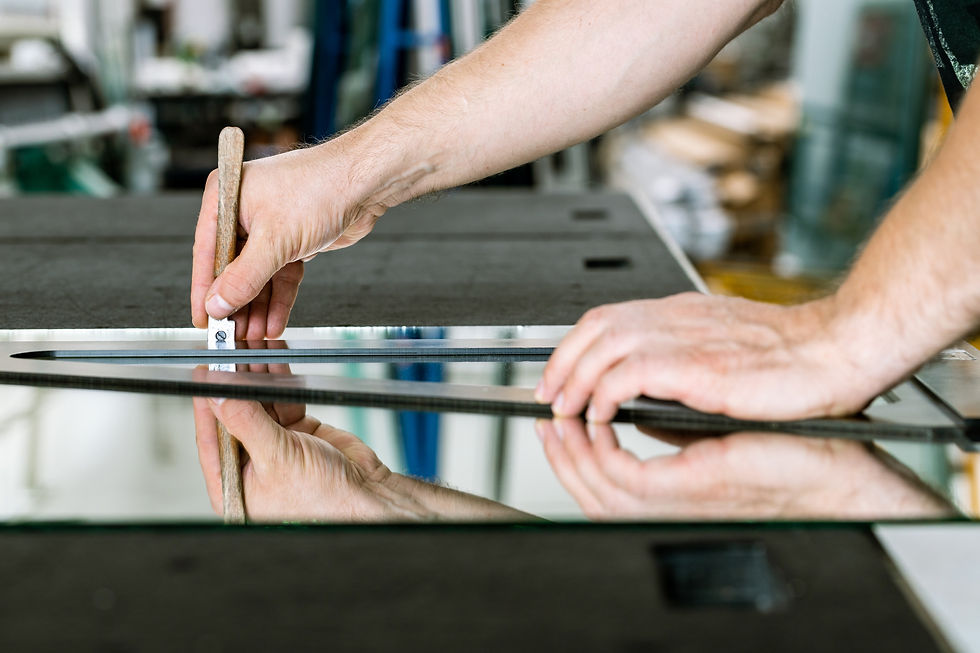How Much Is Glass Cut to Size?
- Best in Glass

- Oct 3
- 5 min read
If you’re planning a project and need made-to-measure glass, you’ll want a clear idea of what drives the price. The short answer is that cut-to-size glass is priced on specification — thickness, edge finish, holes and notches, quantity, and delivery. Because of these variables, reputable suppliers quote each job individually rather than publishing fixed prices.
Below is a simple guide to how pricing works and how to get the best value without compromising safety or finish.

What affects the cost of cut-to-size glass?
1) Glass type and thickness
Toughened (tempered) safety glass is the norm for partitions, balustrades, doors, and furniture tops because it’s stronger and safer. Thicker sheets use more material and take longer to process, so price steps up with thickness. For many interior applications, 10 mm or 12 mm are common, but always follow hardware guidance.
2) Panel size and yield
Factories cut from large stock sheets. Better yield (less waste) means better pricing. A panel that nests neatly with others will often be cheaper per m² than an awkward single piece, even if the areas match.
3) Edge finishing
Cut edges can be arrised (safely seamed) or flat-polished for a premium, furniture-grade finish. Polishing adds time and tooling, so it increases cost. For partitions and balustrades, polished edges are often chosen for a neat, visible finish.
4) Holes, notches, and shaping
Any holes for hinges, handle cut-outs, notches, or radius corners require CNC processing before the glass is toughened. Each operation adds to the cost. If you can standardise holes across a batch, you’ll usually see a better rate.
5) Quantity and repetition
Batch runs are more economical than one-offs. Repeating the same panel across a project reduces programming and set-up time, so the unit price falls.
6) Lead time and delivery
Nationwide delivery is available, and cost depends on route planning, weight, and packaging. If timing is flexible, you may benefit from standard delivery windows rather than special trips.
Typical specifications by application (and how they influence price)
Glass partitioning. Panels with U-channel tolerances and door hardware holes. Expect costs to be driven by thickness (often 10–12 mm), polished edges, and CNC hole counts. Explore components in our glass partitioning systems.
Glass balustrades and railings. Size is dictated by clamp positions or base shoes. Consistency across panels keeps costs efficient. See options for glass balustrades and railings.
Table tops and furniture. Edge quality is on show, so flat-polished edges and radius corners are common. That adds some processing cost, but the finish is worth it. Browse our glass table tops.
Hardware and tools. Using fittings designed for glass avoids rework. The right brackets, seals, and silicones speed up installs and reduce site risk. See our glass hardware and tools.
How suppliers calculate your quote
Most trade quotes include:
Glass type and thickness
Panel sizes and quantities
Edge finish (arrised or polished)
CNC operations (holes, notches, shaping)
Packaging and delivery
Lead time based on the workload and your deadline
Provide this information up front and you’ll get a faster, cleaner price.
Measuring and specification tips that save money
Measure at multiple points. Work to the tightest dimension and allow clearance for channels, gaskets, or thermal movement. Avoiding a reorder is the biggest cost saver of all.
Follow hardware drawings. Hole diameters, centres, and edge distances must match the manufacturer’s data.
Batch where possible. Repeating a panel across a project lowers your per-unit price and speeds production.
Choose the right edge. If a panel sits in a channel and the edge isn’t exposed, an arrised edge may be perfectly acceptable.
Plan radii sensibly. Consistent, standard corner radii and hole sizes are cheaper to run than a mix of custom radii.
Not sure what clearance to allow? Email a quick sketch to contact@bestinglass.uk and our team will advise before you commit.
Why prices vary between suppliers
Differences usually come down to processing capability, material sourcing, and workload. A factory with the right CNC capacity for your spec may turn the job around quicker and at a sharper price. Equally, suppliers focused on very small one-off jobs sometimes charge a premium for set-up. For trade customers, a balance of value, quality, and timing is what matters.
Best in Glass is a Staffordshire-based, supply-only partner serving the UK with stock and bespoke options. Our reviews highlight helpful advice and reliable service — two things that save time and cost on site.
How to get an accurate price today
List each panel with width × height, thickness, and edge finish.
Mark holes/notches with sizes and centres from the nearest edges.
Confirm quantity and delivery postcode.
Share any drawings (PDF/DWG acceptable).
Tell us your timeframe.
Send the details to contact@bestinglass.uk or call 01889 226444. We’ll confirm current lead times and give you a clear, itemised quote. Nationwide delivery is available, and lead times differ based on size and complexity.
Can I get a ballpark price without drawings?
You can get an indicative guide by telling us rough sizes, thickness, and whether you need polished edges or holes. For a firm quote, we’ll need exact dimensions. Because toughened glass can’t be cut after tempering, accuracy at the ordering stage is essential.
Stock vs bespoke — which is cheaper?
For simple tasks, stock sizes from our catalogue can be more cost-effective and available quickly. For trade installations where fit and finish matter, bespoke panels avoid site trimming (which isn’t possible with toughened glass) and prevent wasted time. Often the total project cost is lower when you order the correct, made-to-measure parts from the start.
Need help choosing the right specification?
We talk to installers every day. If you’re weighing up 10 mm versus 12 mm, unsure about edge finishes, or deciding between stock and bespoke, we’ll give honest, practical guidance. Our goal is to help you order once and install with confidence.
Speak to our team on 01889 226444 or email contact@bestinglass.uk.
FAQs
How are prices for glass cut to size calculated?
They’re based on glass type and thickness, panel size, edge finish, any holes or shaping, quantity, and delivery. Share your spec for a firm quote.
Is polished edging worth the extra cost?
If the edge is visible, yes. Polished edges look professional and are safer to handle. Hidden edges in channels may only need an arris.
Does adding holes and notches increase the price a lot?
Each CNC operation adds cost and time. Standardising hole sizes and keeping a consistent layout across panels helps control pricing.
Can I trim toughened glass on site to save money?
No. Toughened glass cannot be cut or ground after tempering. Order the correct sizes from the start.
Do you deliver cut-to-size glass nationwide?
Yes. We’re based in Staffordshire and deliver across the UK. Lead times depend on quantity and complexity — we’ll confirm when quoting.




Comments